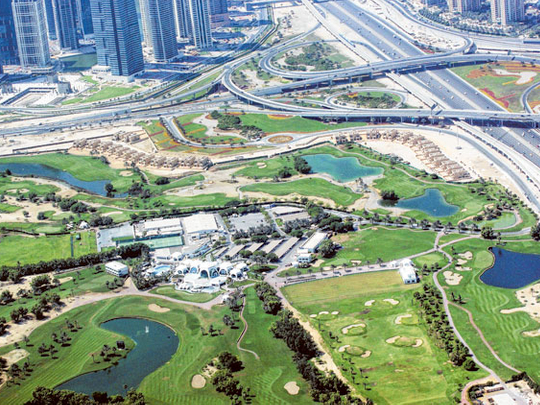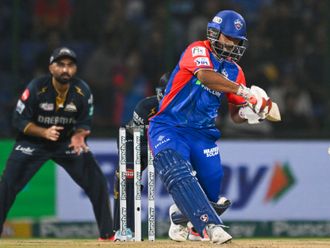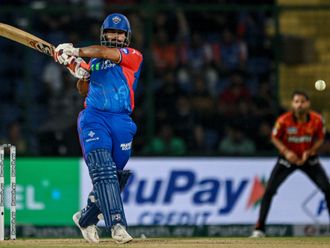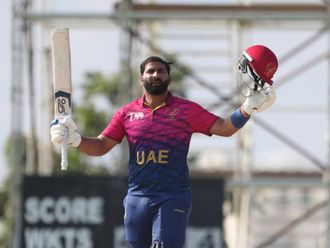
Dubai: When the former president of Pakistan Mohammad Zia-ul-Haq struck the first ball to open Emirates Golf Club on March 8, 1988, he wasn’t just inaugurating grass golf in the UAE, but also promoting Dubai for the first time as a premier destination for sports tourism.
But, after perishing in a plane crash just five months later, he would never get to realise this vision of His Highness Shaikh Mohammad Bin Rashid Al Maktoum, Vice-President and Prime Minister of the UAE and Ruler of Dubai.
Twenty-five years on and the one-kilometre-square green oasis in the middle of the then barren desert, which was 25km west of the centre of town, is now the beating heart of a modern metropolis.
This week sees the official celebration of that silver jubilee in the form of special 25-hole round of golf, parties and book launches, with founding members returning in droves to fondly reminisce about the past.
One such example is founding course manager and club historian Rodney Bogg. Standing at the first tee surrounded by a backdrop of high-rise apartment blocks and a winding metro line parallel to a 12-lane highway, he said: “Where we are now you would have been able to see most of the course and almost certainly the sea, if not hear it.
“Shaikh Zayed Road was called the Abu Dhabi Highway and it was a four-lane carriageway with no central reservation. The nearest building going back into town was the Metropolitan Hotel and if you went on top of the eighth fairway you would have seen all 18 holes and, on a clear day, the World Trade Centre.
“There was only one tree on the entire plot when the earthmovers came in, but now you could be almost anywhere in the world, as trees are ten-foot tall in places.
“Everything is right for photosynthesis providing you can give it enough water. But at first there was a lot of scepticism [about the course], the cost of water was so prohibitive and many thought it would never work. It was unknown and pioneering,” he added.
While an entire chapter of Bogg’s 283-page book about the club entitled ‘The Desert Miracle’ documents the flora, fauna and ecology of this once desolate landscape, it’s merely a metaphor for much wider migration patterns encouraged by the club’s opening.
Dubai is now a sprawling and cosmopolitan global centre of commerce and culture, home to two million inhabitants up from 370,000 in the mid-1980s.
Exposed to the world and grown largely using sport as a vehicle for tourism to diversify from its traditional oil wealth, Emirates Golf Club is said to have played a big part in Dubai’s meteoric rise.
Since hosting the first European Tour event outside the continent in 1989, TV coverage documenting wins for Seve Ballesteros, Ernie Els and Tiger Woods took the city to many a living room in the world.
“It was one of the first world-class sporting events in Dubai,” said Dubai Golf CEO Christopher May. “We’ve been fortunate enough to see many more since like the rugby, tennis and horse racing events, but golf was a catalyst and this course was instrumental in terms of putting Dubai on the map and attracting tourism. Without the Majlis Course, many others in the region wouldn’t have been built.
“It helped the growth of Emirates airline, which in turn sparked hotels, real estate, malls and beaches. Everything is interlinked, but there’s no doubt this course helped Dubai to become the world-renowned tourist destination it is today,” May added.
Originally attracting just 150 members, the club now boasts 1,750, with a one-third market share of the UAE’s annual 30,000 overseas golf visitors. Annual memberships started at Dh12,000, 25 years ago and now stand at Dh29,000.
Bogg said: “If you put into perspective the cost of this operation in this climate — the amount of water, fertiliser and labour — the costs are significant. Membership costs have probably gone up 300 per cent since 1988, but if you look at cost of living and wages, it’s probably relative.
“We’ve managed to keep fees reasonable by operating on a commercial basis and that’s the future of golf, as apart from [needing] rich members you’ve got to be commercial to exist.”
May agreed: “The original Majlis course remains the same, but the club has changed a lot. We now have 36 holes thanks to the introduction of the Faldo course as well as a great par-three course. We’ve also got fantastic restaurant and recreational facilities, including a gym, pool and tennis courts, and the club house has also been renovated.
“Whether it be updating the irrigation system or installing floodlights, the facility has evolved thanks to constant reinvestment and that’s really important to ensure that it’s not only the number one golf club in the region, but that it remains that way for many years to come.”









